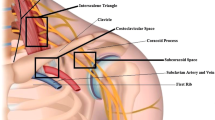Abstract.
The local intramuscular application of botulinum toxin into the triceps, temporarily blocks activity and thus reduces the resistance to the weak but contracting biceps. Six children (2–4 years of age) presenting with severe biceps/triceps co-contractions after nerve regeneration (spontaneous regeneration in three cases, early microsurgical reconstruction in three cases) of an obstetrical brachial plexus lesion, were treated with local injections of 25 –50 mouse units (DYSPORT, R) botulinum toxin type A at two sites of the triceps muscle. Botulinum toxin injections were monitored by EMG recordings. Clinical testing (muscle power graded by the British Medical Research Council classification and measurement of the active range of motion, using the Neutral-0-Method) and EMG studies were performed prior to and after injections. Follow-up was at least 18 months. Mean active elbow flexion prior to application was about 50° (range: 20–60°) and muscle power was graded M1 (two cases) to M2 (four cases). Eighteen months after injection, mean elbow flexion was about 100° (range: 80–120°) and muscle power was graded as M2+ (elbow flexion without gravity in one case) to M4 (five cases). On EMG examination, a clear reduction of triceps contractions during biceps activity was observed. Temporary paralysis of the triceps after injection persisted for 16–44 weeks, with an average of 25.3 weeks. In order to achieve a stable elbow flexion at the M4 level, the Botox injection had to be repeated 2–3 times. The average time of treatment took 8–12 months. There was no recurrence of co-contraction in any of the patients after an 18 month follow-up. Moreover, no severe complications occurred. Local injections of botulinum toxin type A represents a new effective nonoperative tool for co-contracture treatment in obstetrical brachial plexus lesions in children.
Similar content being viewed by others
Author information
Authors and Affiliations
Additional information
Electronic Publication
Rights and permissions
About this article
Cite this article
Hierner, R., Rollnik, J., Berger, A. et al. Botulinum toxin type a for the treatment of biceps/triceps co-contraction in obstetrical brachial plexus lesions. Eur J Plast Surg 24, 2–6 (2001). https://doi.org/10.1007/s002380000218
Received:
Accepted:
Published:
Issue Date:
DOI: https://doi.org/10.1007/s002380000218




